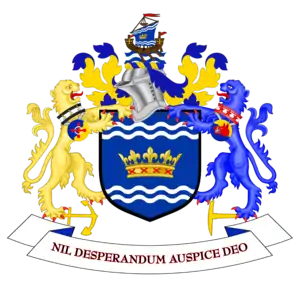Sunderland A.F.C.
Sunderland Association Football Club (/ˈsʌndərlənd/ (![]() listen), locally /ˈsʊndlən/) is an English professional football club based in the city of Sunderland, Tyne and Wear. Sunderland plays in League One, the third tier of English football. Since its formation in 1879,[1] the club has won six top-flight (First Division, now the Premier League) titles (1892, 1893, 1895, 1902, 1913 and 1936), a total only bettered by five other clubs, and has finished runners-up five times. The club has also won the FA Cup twice (1937 and 1973) and been runners-up twice (1913 and 1992), as well as winning the FA Charity Shield in 1936 and being finalists the following year. Sunderland have also been Football League Cup finalists in 1985 and 2014.
listen), locally /ˈsʊndlən/) is an English professional football club based in the city of Sunderland, Tyne and Wear. Sunderland plays in League One, the third tier of English football. Since its formation in 1879,[1] the club has won six top-flight (First Division, now the Premier League) titles (1892, 1893, 1895, 1902, 1913 and 1936), a total only bettered by five other clubs, and has finished runners-up five times. The club has also won the FA Cup twice (1937 and 1973) and been runners-up twice (1913 and 1992), as well as winning the FA Charity Shield in 1936 and being finalists the following year. Sunderland have also been Football League Cup finalists in 1985 and 2014.
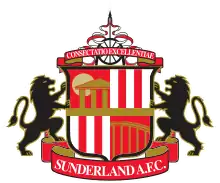 | |||
| Full name | Sunderland Association Football Club | ||
|---|---|---|---|
| Nickname(s) | The Black Cats | ||
| Short name | SAFC | ||
| Founded | 1879 (as Sunderland and District Teachers) | ||
| Ground | Stadium of Light | ||
| Capacity | 49,000 | ||
| Owner | Stewart Donald | ||
| Chairman | Vacant | ||
| Head coach | Lee Johnson | ||
| League | League One | ||
| 2019–20 | League One, 8th of 23 | ||
| Website | Club website | ||
|
| |||
Sunderland play their home games at the 49,000-capacity all-seater Stadium of Light having moved from Roker Park in 1997. The original ground capacity was 42,000 which was increased to 49,000 following expansion in 2000. The club have a long-standing rivalry with nearby club Newcastle United, with whom they have contested the Tyne–Wear derby since 1898. The club have played in red and white-striped shirts and black shorts for nearly the entirety of its history.[2]
History
Early years and the "Team of All Talents" (1879–1908)
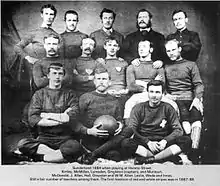
The club was founded as Sunderland and District Teachers A.F.C. by schoolmaster James Allan in what has commonly been believed to be October 1879.[3] However, evidence suggests that the club was not formally created until a year later, on 25 September 1880.[4] It was renamed as Sunderland A.F.C. and became open to more than just school teachers in October 1880.[4]
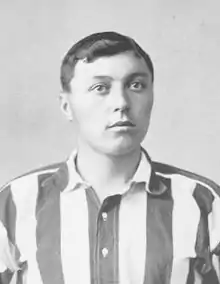
Sunderland joined The Football League for the 1890–91 season.[5] They replaced Stoke, who had failed to be re-elected, becoming the first new club to join the league since its inauguration in 1888.[6] Tom Watson became Sunderland's first manager when he was appointed in 1888.[7] During the late 19th century, they were declared the "Team of All Talents" by William McGregor,[8] the founder of the league, after a 7–2 win against Aston Villa.[8] Sunderland won the league championship in the 1891–92 season, one season after joining The Football League. The club's 42 points were five clear of nearest rivals Preston North End, and this performance led The Times to describe the players as "a wonderfully fine team".[9] Sunderland successfully defended the title the following season, aided by their Scottish centre forward John Campbell, who broke the 30-goal mark for the second time in consecutive seasons. In the process, they became the first team to score 100 goals in a season, a feat not matched until 1919–20, when West Bromwich Albion set a new record.[10]

Sunderland came close to winning a third successive league championship in the 1893–94 season, finishing second behind Aston Villa. However, they regained the title in the 1894–95 season, ending the season five points ahead of Everton, with Campbell becoming league top scorer for the third time.[11] After winning the English League Championship, Sunderland beat Heart of Midlothian, the champions of the Scottish League, 5–3 in a game described as the "World Championship" match.[12][13][14]
Important to Campbell's success in attack were other "Team of All Talents" players from Scotland: Jimmy Hannah and Jimmy Millar—the many players who came from Scotland to play in England in those days were known as the Scotch Professors.[15][16] Their goalkeeper Ned Doig set a 19th-century world record by not conceding any goals in 87 of his 290 top division appearances (30%).[17]
The wealthy miner Samuel Tyzack, who alongside and shipbuilder Robert Turnbull funded the "Team of All Talents", often pretended to be a priest while scouting for players in Scotland, as Sunderland's recruitment policy in Scotland enraged many Scottish fans. In fact, the whole Sunderland lineup in the 1895 World Championship was made from entirely Scottish players.[13]
After taking Sunderland to three English League championship titles manager Watson resigned at the end of the 1895–96 season, in order to join Liverpool.[18] Robert Campbell replaced him.[18] From 1886 until 1898, Sunderland's home ground was in Newcastle Road.[19] In 1898, the club moved to what would become their home for almost a century, Roker Park.[20] Initially the ground had a capacity of 30,000.[20] However, over the following decades it was continually expanded, and at its peak would hold an official crowd of over 75,000 in a sixth round FA Cup replay against Derby County on 8 March 1933.[21] Campbell did not achieve the same playing success as former manager Watson, as Sunderland failed to win any titles in his three seasons at the club, which he left in the 1898–99 season to join Bristol City.[22]
Scotsman Alex Mackie replaced Campbell as manager for the 1899 season.[23] Following a second-place finish in 1900–01, the club won their fourth league title in the 1901–02 season, beating Everton by a three-point margin.[23] They followed this up with victory in the Sheriff of London Charity Shield, a competition featuring the best amateur and professional sides in England and precursor to the Charity Shield. Sunderland beat leading amateurs Corinthians 3–0.[24]
In December 1902, Arthur Bridgett joined Sunderland. He went on to captain the "Black Cats" for ten years and gain eleven England caps, making him the club's second most-capped England international behind Dave Watson.[25]
In 1904, Sunderland's management was embroiled in a payment scandal involving player Andrew McCombie. The club was said to have given the player £100 (£10.9 thousand today) to help him start his own business, on the understanding that he would repay the money after his benefit game.[26] However, McCombie refused to repay the money, claiming it had been a gift. An investigation conducted by the Football Association concluded that the money given to McCombie was part of a "re-signing/win/draw bonus", which violated the Association's rules. Sunderland were fined £250 (£27.1 thousand today), and six directors were suspended for two and a half years for not showing a true record of the club's financial dealings. Mackie was also suspended for three months for his involvement in the affair.[27][26]
Further league championship titles (1908–1945)
On 5 December 1908, Sunderland achieved their highest ever league win, against north-east rivals Newcastle United. They won the game 9–1; Billy Hogg and George Holley each scored hat-tricks, while Arthur Bridgett scored two.[28] Under Irish manager Bob Kyle and with Scottish Charles Thomson as captain, the club won the league again in 1913,[29] but lost their first FA Cup final 1–0 to Aston Villa, in a very tough loss.[30] This was the closest the club has come to winning the league title and the FA Cup in the same season.[31]
This period in their history also saw the goalscoring of Charlie Buchan, who went on to score 221 goals for Sunderland,[32] making himthe second highest goalscorer in the club's history, behind Bob Gurney.[33] Holley was the league's top scorer in the season before Sunderland won the title.
Two seasons later the First World War brought the league to a halt. After the league's resumption, Sunderland came close to winning another championship in the 1922–23 season, when they were runners-up to Liverpool.[34] They also came close the following season, finishing third, four points from the top of the league.[35] The club escaped relegation from the First Division by one point in the 1927–28 season despite 35 goals from Dave Halliday.
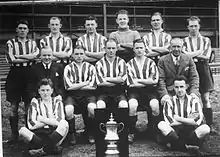
The point was won in a match against Middlesbrough, and they finished in fifteenth place.[36] Halliday improved his goal scoring to 43 goals in 42 games the following season,[37] an all-time Sunderland record for goals scored in a single season.[5]
The club's sixth league championship came in the 1935–36 season under Scottish manager Johnny Cochrane.[38] They scored 109 goals during the season, with Raich Carter and Bobby Gurney each scoring 31.[39] The League championship led to Sunderland playing in the Charity Shield against FA Cup-winners Arsenal. Sunderland won the shield after goals from Eddie Burbanks and Raich Carter.[40]
Despite winning the league, the season did not go without tragedy. The young goalkeeper of the team, Jimmy Thorpe, died as a result of a kick in the head and chest after he had picked up the ball following a backpass in a game against Chelsea at Roker Park. He continued to take part until the match finished, but collapsed at home afterwards and died in hospital four days later from diabetes mellitus and heart failure 'accelerated by the rough usage of the opposing team'.[41] This tragic incident led to a change in the rules, whereby players were no longer allowed to raise their foot to a goalkeeper when he had control of the ball in his arms.[42]
They won the FA Cup the following season, after a 3–1 victory against Preston North End at Wembley Stadium.[43]
The remainder of the decade saw mid-table finishes, until the league and FA Cup were suspended for the duration of the Second World War. Some football was still played as a morale boosting exercise, in the form of the Football League War Cup. Sunderland were finalists in the tournament in 1942, but were beaten by Wolverhampton Wanderers.[44]
"The Bank of England" club, financial troubles and three cup finals (1945–1995)
For Sunderland, the immediate post-war years were characterised by significant spending; the club paid £18,000 (£641 thousand today) for Carlisle United's Ivor Broadis in January 1949.[26] Broadis was also Carlisle's manager at the time, and this is the first instance of a player transferring himself to another club.[45] This, along with record-breaking transfer fees to secure the services of Len Shackleton and the Welsh international Trevor Ford, led to a contemporary nickname, the "Bank of England club".[46] The club finished third in the First Division in 1950,[47] their highest finish since the 1936 championship.
The late 1950s saw a sharp downturn in Sunderland's fortunes, and the club was once again implicated in a major financial scandal in 1957.[27] Found guilty of making payments to players in excess of the maximum wage, they were fined £5,000 (£121,000 today), and their chairman and three directors were suspended.[26][48][49] The following year, Sunderland were relegated from the highest division for the first time in their 68-year league history.[50]
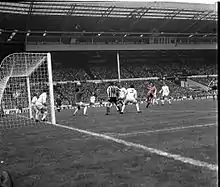
Sunderland's absence from the top flight lasted six years. The club came within one game of promotion back to the First Division in the 1962–63 season. Sunderland required only a draw in their final game against promotion rivals Chelsea, who had another game left to play after this match, to secure promotion. However, they were defeated,[51] and Chelsea won their last game 7–0 to clinch promotion, finishing ahead of Sunderland on goal average.[52] After the close call in the previous season, the club was promoted to Division One in 1964 after finishing in second place. Sunderland beat Charlton Athletic in the final stages of the season, where they clinched promotion with a game to spare.[53] At the end of the decade, they were again relegated to the Second Division after finishing 21st.[54]
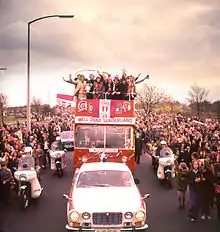
Sunderland won their last major trophy in 1973, in a 1–0 victory over Don Revie's Leeds United in the FA Cup Final.[55] A Second Division club at the time, Sunderland won the game thanks mostly to the efforts of their goalkeeper Jimmy Montgomery, who saved two of Leeds shots at goal in quick succession, one being from hot-shot Peter Lorimer.[56] Ian Porterfield scored a volley in the 30th minute to beat Leeds and take the trophy.[56] Since 1973 only two other clubs, Southampton in 1976,[57] and West Ham United in 1980,[58] have equalled Sunderland's achievement of lifting the FA Cup while playing outside the top tier of English football.
By winning the 1973 FA Cup Final, Sunderland qualified for the UEFA Cup Winners' Cup, the club's only appearance in European competition to date.[59] Sunderland beat Vasas Budapest 3–0 on aggregate, and were drawn against Lisbon club Sporting in the second round.[59] They won the first leg at Roker Park 2–1 but were defeated 2–0 in the away leg, and were knocked out of the competition 3–2 on aggregate.[59] After spending six seasons in the Second Division, Sunderland were promoted to Division One in the 1975–76 season; they topped the table over Bristol City by three points.[60] However, Sunderland were relegated the following season back into Division Two, without their FA Cup Final winning manager Bob Stokoe, who had resigned because of health problems at the start of the season.[61] The club celebrated its 100-year centenary in the 1979–80 season with a testimonial against an England XI side, which they lost 2–0.[62]
Sunderland appeared in their first League Cup final in 1985, but lost 1–0 to Norwich City.[63] In 1987, Sunderland saw one of the lowest points in their history, when they were relegated to the Third Division of the English league for the first time.[64] Under new chairman Bob Murray and new manager Denis Smith, the club was promoted the following season.[65] In 1990, they were promoted back to the top flight in unusual circumstances. Sunderland lost to Swindon Town in the play-off final, but Swindon's promotion was revoked after the club was found guilty of financial irregularities and Sunderland were promoted instead.[66] They stayed up for one year before being relegated on the final day of the following season.[67]

Sunderland's next outing in a major final came in 1992 when, as a Second Division club, they returned to the FA Cup final. There was to be no repeat of the heroics of 1973, as Sunderland lost 2–0 to Liverpool.[68]
New stadium, promotions and relegations (1995–2006)
In 1995, they faced the prospect of a return to the third-tier of English football.[69] Peter Reid was brought in as manager, and quickly turned things around. Reid's time in charge had a stabilising effect; he remained manager for seven years.[70] After promotion from Division One in the 1995–96 season,[71] Sunderland began their first season in the Premier League, but finished third from the bottom and were relegated back to the First Division,[72] despite beating Manchester United,[73] Arsenal[74] and Chelsea.[75]
In 1997, Sunderland left Roker Park, their home for 99 years. Bearing fond memories of the stadium, former Sunderland player Len Shackleton said, "There will never be another place like Roker".[76] The club moved to the Stadium of Light, a 42,000-seat arena that, at the time, was the largest stadium built in England after the Second World War.[77] The capacity was later increased to 49,000.[78]
Not all fans were satisfied with the move. Following the demolition of Roker Park, playwright Tom Kelly and actor Paul Dunn created a one-man play called I Left My Heart at Roker Park about a fan struggling with the move and what the stadium meant for him; the show had its first run in 1997, and has been revived since.[79][80]
Sunderland returned to the Premier League as First Division champions in 1999 with a then-record 105 points.[81] Sunderland's 1999–2000 season started at Stamford Bridge, where Chelsea beat them 4–0.[82] However, in the return match later in the season Sunderland turned the tables on Chelsea, avenging their 4–0 defeat with a 4–1 win at the Stadium of Light.[83] Sunderland also achieved a 2–1 victory over rivals Newcastle United at St. James' Park,[82] a result which helped bring about the resignation of Newcastle's manager, Ruud Gullit.[84] At the end of the season Sunderland finished seventh, with Kevin Phillips winning the European Golden Shoe in his first top-flight season, scoring 30 goals.[85]
Another seventh-place finish in the 2000–01 season was followed by two less successful seasons, and they were relegated to the second-tier with a then-record low 19 points in 2003.[5][86] Former Ireland manager Mick McCarthy took over at the club, and, in 2005, he took Sunderland up as champions for the third time in less than 10 years.[5] However, the club's stay in the top flight was short-lived as Sunderland were once again relegated, this time with a new record-low total of 15 points. McCarthy left the club in mid-season, and he was replaced temporarily by former Sunderland player Kevin Ball.[87] The record-low 15-point performance was surpassed in the 2007–08 season by Derby County, who finished on 11 points.[88]
Drumaville Consortium takeover and Ellis Short era (2006–2016)
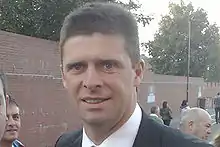
Following Sunderland's relegation from the Premier League, the club was taken over by the Irish Drumaville Consortium,[5] headed by ex-player Niall Quinn, who appointed former Manchester United captain Roy Keane as the new manager.[89] Under Keane, the club rose steadily up the table with an unbeaten run of 17 games[90] to win promotion to the Premier League,[91] and were named winners of the Championship after beating Luton Town 5–0 at Kenilworth Road on 6 May 2007.[92] Following an inconsistent start to the 2008–09 season, Keane resigned.[93] Before the start of the following campaign, Irish-American businessman Ellis Short completed a full takeover of the club,[94] and Steve Bruce was announced as the next manager on 3 June.[95]
One of Bruce's first signings, Darren Bent, cost a club record fee of £10 million, broken a year later when they bought Ghana international Asamoah Gyan for around £13 million.[96] Sunderland started the 2010–11 season strongly, but after Bent left for Aston Villa in January 2011 in a deal potentially worth £24 million, a record transfer fee received for the club,[97] they eventually finished 10th — which was still their highest top-flight finish for 10 years.[98] After being named Sunderland's Young Player of the Year for two seasons in a row,[99] at the end of the 2010–11 season, Jordan Henderson was transferred to Liverpool, where he went on to become captain and win the Champions League, and the Premier League.[100][101]
Short replaced Quinn as chairman in October 2011, with Quinn becoming Director of International Development.[102] Bruce was sacked in November 2011,[103][104] and replaced by Martin O'Neill.[105][106] In February 2012, Quinn left the club with immediate effect.[107] O'Neill was sacked in March 2013[108] and Italian Paolo Di Canio was announced as his replacement the following day.[109] The appointment prompted the immediate resignation of club Vice Chairman David Miliband due to Di Canio's "past political statements".[110] Fans protested against his appointment, and Facebook pages opposing Di Canio's arrival were created and gained thousands of likes within hours.[111] It also met opposition from the Durham Miners' Association,[112] which threatened to remove one of its mining banners from Sunderland's Stadium of Light, which is built on the former site of the Wearmouth Colliery, as a symbol of its anger over the appointment.[113][114]
Sunderland went on to avoid relegation with one game to go. Di Canio was sacked after a poor start to the 2013–14 season, and reports of a complete breakdown in relations with his players.[115] Gus Poyet was announced as his replacement,[116] and led Sunderland to the 2014 Football League Cup Final, where they were defeated 3–1 by Manchester City.[117] In March 2015 Poyet was sacked,[118] and veteran Dutchman Dick Advocaat was appointed as the club's new head coach,[119] saving the club from relegation.[120] Eight games into the 2015–16 season he resigned from the position.[121] Sam Allardyce was appointed the next manager in October 2015, and the club was again saved from relegation at the end of the season.[122]
Back-to-back relegations and ownership changes (2016–present)
In July 2016, Allardyce left the club to be announced as manager for the English national team,[123] and former Everton and Manchester United manager David Moyes was appointed as his replacement.[124] Under Moyes, Sunderland made the worst ever start to a Premier League season, taking just two points from their opening 10 matches.[125] The club was relegated to the second tier for the first time in 10 years at the end of the 2016–17 season, finishing bottom of the table with 24 points,[126] and Moyes resigned as manager.[127] In June 2017, goalkeeper Jordan Pickford, a product of Sunderland's academy who joined the club aged eight, was transferred to Everton for a fee of £25 million, rising to a possible £30 million; a record for a British goalkeeper.[128]
Following relegation, Simon Grayson was announced as the new manager of the club.[129] Under Grayson, the club made a very poor start to the 2017–18 EFL Championship season (which was documented in the Netflix series Sunderland 'Til I Die), taking only 2 wins in 14 games. Following a 3–3 draw against Bolton, Grayson was sacked,[130] and Wales head coach Chris Coleman replaced him in November 2017.[131] In April 2018, after a second consecutive relegation, this time to League One,[132] the club was sold to a group led by Stewart Donald, the chairman of Eastleigh, and Coleman was released from his contract.[133]
St Mirren manager Jack Ross was appointed as the new manager in May 2018.[134] In the club's first season in League One they finished 5th and reached the play-off final, but lost to Charlton Athletic at Wembley. After a disappointing start to the 2019–20 season, Ross was sacked in October 2019.[135] He was replaced by former Bolton manager Phil Parkinson on 17 October.[136] Sunderland finished the season in 8th place, their lowest ever league position, with the final standings ultimately being determined by points per game due to football's suspension due to the COVID-19 pandemic.[137]
Colours and crest
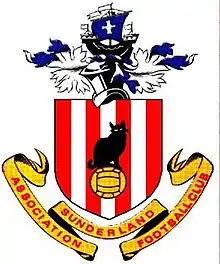

Sunderland played in an all blue strip from their formation until 1884,[5] when they adopted a red and white halved strip.[138] They assumed the current strip of red and white stripes in the 1887–88 season.[139] Their badge included a ship, the upper part of the Sunderland coat of arms, a black cat, and a football in front of Sunderland's red and white stripes.[140] In 1972 the badge was changed,[141] removing the black cat but still including a ship, a football and the background of red and white stripes.[142] This badge was first used on the match day shirt in 1977, replacing the simple black 'SAFC' initials which had been used since 1973.[143] The top section and border of the badge was coloured in blue until 1991, when it changed to black.[143]
To coincide with the move from Roker Park to the Stadium of Light in 1997, Sunderland released a new crest divided into four quarters; the upper right and lower left featured their traditional red and white colours, but the ship was omitted. The upper left section features the Penshaw Monument and the lower right section shows the Wearmouth Bridge.[144] A colliery wheel at the top of the crest commemorates County Durham's mining history, and the land the Stadium of Light was built on, formerly the Monkwearmouth Colliery. The crest also contains two lions, the black cats of Sunderland, and a banner displaying the club's motto, Consectatio Excellentiae, which means "In pursuit of excellence".[144]
Stadium
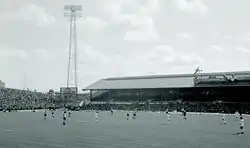
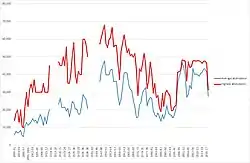
Sunderland have had eight grounds throughout their history; the first was at Blue House Field in Hendon in 1879. The ground was close to the place where Sunderland formed, at Hendon Board School; at that time the rent for use of the ground was £10 (£1 thousand today).[26][145] The club then used a number of fields, one of which was near The Cedars road,[146] before relocating to Groves Field in Ashbrooke in 1882 for one season.[147] The club's third stadium was Horatio Street in Roker, the first Sunderland stadium north of the River Wear; the club played a single season there before another move,[148] this time to Abbs Field in Fulwell for two seasons. Abbs Field was notable for being the first Sunderland ground to which they charged admission.[149]
Sunderland moved to Newcastle Road in 1886. By 1898, the ground reached a capacity of 15,000 after renovations, and its rent had risen to £100 (£11.2 thousand today) a year.[26][150] Near the turn of the 20th century, Sunderland needed a bigger stadium. They returned to Roker and set up home in Roker Park. It was opened on 10 September 1898, and the home team played a match the same day against Liverpool,[151] which they won. The stadium's capacity increased to 50,000 after redevelopment with architect Archibald Leitch in 1913. Sunderland were nearly bankrupted by the cost of renovating the Main Stand, and Roker Park was put up for sale but no further action was taken. On 8 March 1933, an overcrowded Roker Park recorded the highest ever attendance at a Sunderland match, 75,118 against Derby County in a FA Cup sixth round replay.[5] Roker Park suffered a bombing in 1943, in which one corner of the stadium was destroyed. A special constable was killed while patrolling the stadium. By the 1990s, the stadium was no longer large enough, and had no room for possible expansion.[152] In January 1990, the Taylor Report was released after overcrowding at the Hillsborough Stadium resulted in 96 deaths, an incident known as the Hillsborough Disaster.[153] The report recommended that all major stadiums must be converted to an all-seater design.[154] As a result, Roker Park's capacity was reduced. It was demolished in 1997 and a housing estate built in its place.[151]
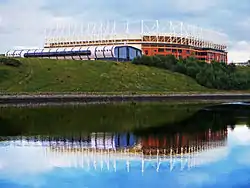
In 1997, Sunderland moved to their present ground, Stadium of Light in Monkwearmouth, which was opened by Prince Andrew, Duke of York. Built with an original capacity of 42,000, it hosted its first game against Dutch team Ajax.[77] The stadium bears a similar name to the Portuguese club Benfica's ground Estádio da Luz, albeit in a different language.
Stadium expansion in 2000 saw the capacity increase to 49,000. A Davy lamp monument stands outside the stadium, and a miners banner was presented to the club by the Durham Miners' Association,[155] as a reminder of the Monkwearmouth Colliery pit the stadium was built on.
Supporters, rivalries & hooliganism
Attendance and following
The club has had a historically large and passionate following, with the club seeing attendance figures larger than other more fashionable clubs. For instance a 2019 by the International Centre for Sports Studies (CIES) showed that over the prior 5 seasons (2013 to 2018) Sunderland recorded the 38th highest average attendance in world football with an average of 39,249 fans at the Stadium of Light. Sunderland's average attendance were higher over that period than perennial title challengers such as Juventus F.C. in Italy and FC Porto in Portugal.[156][157] Despite relegation from the Premier League in 2017 the club has continued to post large annual average attendance figures, recording over 30,000 for the 2019 and 2020 seasons, enough for 16th in the country.[158][159] Following relegation from the Championship at the end of the 2017/ 2018 season, Sunderland subsequently broke the League One division attendance record on 26 December 2018 in a match against Bradford City with a total of 46,039 fans.[160][161][162]
Popular songs, music and chants
A song Sunderland fans sing every game and has been described as the anthem of the club is a rendition of "Can't Help Falling in Love" by Elvis Presley, with "Sunderland" being sung repeatedly after "but I can't help falling in love with you."[163][164] Also, during Gus Poyet's tenure, Sunderland supporters started singing "Things Can Only Get Better" by D:Ream.[163] The fans launched a campaign to get the song back into the charts, to coincide with their team's 2014 League Cup Final.[165] A day after the Final, the song re-entered the UK Dance Chart at number 19.[166]
Two of the most famous chants by Sunderland supporters are "I'm Sunderland till I die" and "We're by far the greatest team, the world has ever seen" — with the former being chosen as the title of the Netflix show Sunderland 'Til I Die.[167] One of the oldest Sunderland chants is "Ha'way the lads" which was sung at Sunderland games as far back as the 1960s.[168]
According to a YouGov poll in 2014, supporters of Sunderland showed a tendency towards left politics.[169] They sometimes sing a version of "The Red Flag" during games.[170]
Fanzines and fan produced material
The fans most enduring fanzines is A Love Supreme. The fanzine was first published in 1989 and has won several awards for best Fanzine.[171] Since 2010 the online fanzine Roker Report has operated on the SB Nation blogging network.[172]
Supporters clubs and officially recognised organisations
According to the club there are over 70 branches of official Supporters' Clubs in England and around the world, including North Korea.[173][174] The Official clubs are represented collectively by a Branch Liaison Council that was formed in the 1970s.[175] In addition the club has had a SAFC Liaison Group (SLG) since 1994 that works with fans on club issues and an independent supporters group, the Red & White Army (RAWA).[176][177]
Tyne-Wear derby
Traditionally, Sunderland's main rivals are Newcastle United with whom they contest the Tyne–Wear derby.
Other rivalries
The club shared a rivalry with the now defunct Sunderland Albion in the 1880s and 1890s, a breakaway club formed by Sunderland's founder James Allan.[178]
In recent seasons the club has also developed a minor rivalry with Portsmouth, mainly stemming from the clubs meeting each other 5 times in the 2018-19 season.[179]
Close ties
Conversely, sections of fans share a mutual friendship with Dutch club Feyenoord; this was developed after Wearside shipbuilders found jobs in Rotterdam during the 1970s and 80s.[180]
The club also has good relations with Norwich City, matches between the two clubs being known as the Friendship Trophy, following good rapport in the 1985 Milk Cup final.[181]
Hooliganism
While early hooligan firms of Sunderland fans appeared as far back as the 1970s and the 1980s, like the Vauxies (named after the Vaux Breweries), who were active in the late 1970s and early 1980s, the most famous hooligan firm is the Seaburn Casuals, named after the Seaburn area near Roker Park stadium.[182]
A few days before a game, in 1994, police snatched a pile of weapons and drugs worth thousands of pounds, and were preparing for a showdown with Nottingham hooligans.[182]
Before the 1998 FIFA World Cup, 26 Seaburn Casuals hooligans were arrested in a police raid after a military-issue smoke bomb was let out at a local pub after a fight with bouncers. By the end of the operation, over 60 were facing charges. Some of the Seaburn Casuals hooligans picked up in the raid were also involved with neo-Nazi groups like Combat 18. The operation failed when a judge ruled CCTV footage from the pub inadmissible.[182]
At the end of the 1999–2000 and the 2002–03 seasons, Sunderland topped the hooliganism table in the Premier League with 223 and 154 fan arrests, respectively.[183][184]
In March 2002, the Seaburn Casuals fought with hooligans from the Newcastle Gremlins in a pre-arranged clash near the North Shields Ferry terminal, in what was described as "some of the worst football related fighting ever witnessed in the United Kingdom".[185] The leaders of the Gremlins and Casuals were both jailed for four years for conspiracy, with 28 others jailed for various terms, based on evidence gained after police examined the messages sent by mobile phone between the gang members on the day.[186]
According to official data released by the Football Banning Order Authority, Sunderland's fanbase was named third most dangerous in English football in 2013–14, and in particular, a group called The Sunderland Youth Firm was noted in the context of its clashes with West Ham United fans.[187]
Affiliated clubs
Sunderland have recently created affiliations with several African clubs including Ghana's Asante Kotoko,[188] Egypt's El-Ittihad El-Iskandary,[189] and South Africa's Bidvest Wits. Sunderland also have an affiliation with Belgian side Lierse S.K., allowing the possibility for young African players who would not qualify for a UK work permit to spend three years with Lierse to gain a Belgian passport.[190] In August 2014, Sunderland announced a commercial partnership with Washington D.C. based MLS club D.C. United.[191]
Charitable associations
In 2001, the chairman Bob Murray established the Foundation of Light charity, to help educational development through football, and offers learning centres in addition to scholarships.[192][193] The organisation engaged 280 children within a year, and three years after foundation opened a £1.6m facility along with double-decker buses redeveloped as classrooms.[194][195]
In popular culture
Sunderland were the subject, together with Aston Villa, of one of the earliest football paintings in the world – possibly the earliest – when in 1895 the artist Thomas M. M. Hemy painted a picture of a game between the teams at Sunderland's then ground Newcastle Road.[196]

In 1973, comedian Bobby Knoxall recorded "Sunderland All the Way" for the 1973 FA Cup Final record.[197]
Sunderland AFC were mentioned in the show Auf Wiedersehen, Pet, in the episode "The Girls They Left Behind". In the episode, characters Dennis & Oz go to support Sunderland in Liége despite being Newcastle fans.[198]
Sunderland were mentioned in the May 1997 State Opening of Parliament when Chris Mullin, MP for Sunderland South, stated in his seconding of Queen Elizabeth II's Gracious Speech:
Sunderland has been through hard times in the past, and has survived; as before, we will pick ourselves up, dust ourselves down and come out fighting. Sunderland looks to the future, not the past, and we shall soon be back in the Premier League.[199][200]
In 1998 and following the demolition of Roker Park, playwright Tom Kelly and actor Paul Dunn created a one-man play called "I Left My Heart at Roker Park" about a fan struggling with the move and what Roker Park meant for him – the play originally ran in 1997, and has had a few revivals since.[201][202]
In 1998, BBC broadcast a six-part documentary named Premier Passions. It chronicled Sunderland A.F.C. during the 1996–97 season, in which the club was relegated from the Premier League, the year after winning promotion from the Football League First Division, and the move to Stadium of Light.[203]
In 2018, Netflix released an eight-part documentary called Sunderland 'Til I Die. It documented the events around Sunderland A.F.C. during their 2017–18 season which saw them relegated from the EFL Championship.[204] As a result of the success of the first series, a second season was confirmed, despite opposition from many club members.[205] The opposition was mostly to do with players fearing the series would cause their failures being associated with them for the rest of their careers.[206]
Nicknames
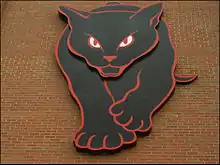
Sunderland's official nickname is 'The Black Cats'. The name was decided upon in a public vote in 2000.[207] Despite the nickname being made official only relatively recently, the black cat has been used as an emblem of the club throughout most of its history. Photographs exist of players holding a black cat which made Roker Park its home in the 1900s and 1910s, and which was fed and watered by the football club.[208] The club's first official badge featured a black cat sitting prominently in its centre and since the 1960s the emblem of the Sunderland A.F.C. Supporters Association has been a black cat.[209][210] A Sunderland supporter, Billy Morris, took a black cat in his chest pocket as a good luck charm to the 1937 FA Cup final in which Sunderland brought home the trophy for the first time and reference has also been made to a "Black Cat Battery", an Artillery battery based on the River Wear during the Napoleonic Wars.[211]
Before this when the team still played at Roker Park, they were known as the Rokerites. This was made obsolete after the club left Roker Park for the Stadium of Light in 1997.[211] Other nicknames used by the media and include the Mackems (believed to be related to the ship building industry and a name for inhabitants of Sunderland) or the Wearsiders, as a reference to the river that the city and broader region of Wearside sits alongside, and in contrast to their Tyneside rivals Newcastle United.[212][213][214][215]
As well as club nicknames, names have been used to define memorable periods in the club's history. The "Team of All Talents" moniker was used during Sunderland's successful period in the 1890s,[5] and Sunderland were known as the "Bank of England club" during the 1950s. This was in reference to the club's spending in the transfer market at the time, which saw the transfer-record broken twice.[5]
Statistics and records
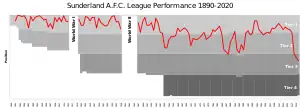
The holder of the record for the most league appearances is Jimmy Montgomery, having made 527 first team appearances between 1961 and 1976.[216] The club's top league goal scorer is Charlie Buchan, who scored 209 goals from 1911 to 1925;[217] Bobby Gurney is the record goalscorer over all competitions with 228 goals between 1926 and 1939.[218] Dave Halliday holds the record for the most goals scored in a season: 43 in the 1928–29 season in the Football League First Division.[217] As of October 2014 John O'Shea is the most capped player for the club, making 100 appearances for the Republic of Ireland.[217]
The club's widest victory margin in the league was in the 9–1 win against Newcastle United in the First Division in 1908. Sunderland's biggest ever win in the FA cup was against Fair field (a non-league team) and the final score was 11–1.[219] Their heaviest defeats in the league were 8–0 against Sheffield Wednesday in 1911, West Ham United in 1968, Watford in 1982 and Southampton in 2014[219] Sunderland joined the top division in England, The Football League, in the 1890–91 season and were not relegated until 1957–58 (a span of 67 seasons). In October 2015, Sunderland defeated rivals Newcastle United for the sixth consecutive time, a new record.
Sunderland's record home attendance is 75,200 for a sixth round replay FA Cup match against Derby County on 8 March 1933.[220]
Record goalscorers
10 Sunderland players have scored 100 goals or more in league competitions.[4] They are as follows:
| Name | Goals | |
|---|---|---|
| 1 | 209 | |
| 2 | 205 | |
| 3 | 156 | |
| 4 | 150 | |
| 5 | 133 | |
| 6 | 118 | |
| 7 | 113 | |
| 8 | 109 | |
| 9 | 108 | |
| 10 | 100 | |
Bobby Gurney holds the record number of goals in all competitions with a combined total of 228 in league and cup games.[221]
Transfers
The biggest transfer fee Sunderland have ever received for one of their players is £30 million for Jordan Pickford, who moved to Everton in July 2017.[128] This was also the biggest fee Sunderland have received for a player produced by the Sunderland academy. The biggest transfer fee paid by Sunderland is £13.6 million for Didier Ndong, who was bought from Lorient in August 2016.[222]
Overall
- Seasons spent at Level 1 of the football league system: 86
- Seasons spent at Level 2 of the football league system: 30
- Seasons spent at Level 3 of the football league system: 4
- Seasons spent at Level 4 of the football league system: 0
As of the 2020–21 season[223]
Kit sponsorship
The first sponsor to appear on Sunderland kits was Cowie's, the business group of then chairman Tom Cowie, between 1983 and 1985.[224][225] The club was sponsored by the Vaux Breweries between 1985 and 1999, with drink brands such as Lambtons sometimes appearing on kits. Subsequently, the club were sponsored by Sunderland car dealership company Reg Vardy from 1999 to 2007.[224] Sunderland were sponsored by the Irish bookmaker Boylesports, who signed a four-year contract with the club in 2007 estimated to be worth £8 million.[226] In April 2010, Sunderland signed a two-year shirt sponsorship deal with tombola, a local online bingo company.[227] On 25 June 2012, Sunderland announced the strengthening of their partnership with the Invest in Africa initiative, with the initiative becoming the club's shirt sponsor for two years. The project is closely linked with Tullow Oil.[228] However, after a year the club announced a new sponsorship deal with South African company Bidvest. On 1 June 2015 Sunderland announced a new sponsorship with Dafabet to appear on the kits for the following season.[229]
The first kit manufacturer to appear on Sunderland kits was Umbro, between 1975 and 1981. French brand Le Coq Sportif produced kits between 1981 and 1983. Nike's first stint as kit manufacturer came between 1983 and 1986, before kits from Patrick (1986–88), Hummel (1988–94), Avec (1994–97) and Asics (1997–00). Nike returned between 2000 and 2004. Diadora produced kits for a solitary season, 2004–05, and Lonsdale made kits between 2005 and 2007. Umbro returned for five seasons between 2007 and 2012, before Adidas became the club's kit manufacturer for the first time in 2012. Nike then returned for a third time as Sunderland's kit manufacturer in 2020.[143]
| Period | Kit manufacturer | Shirt sponsor |
|---|---|---|
| 1975–81 | Umbro | none |
| 1981–83 | Le Coq Sportif | |
| 1983–85 | Nike | Cowie's |
| 1985–86 | Vaux Breweries | |
| 1986–88 | Patrick | |
| 1988–94 | Hummel | |
| 1994–97 | Avec | |
| 1997-00 | Asics | |
| 2000–04 | Nike | Reg Vardy |
| 2004–05 | Diadora | |
| 2005–07 | Lonsdale | |
| 2007–10 | Umbro | Boylesports |
| 2010–12 | Tombola | |
| 2012–13 | Adidas | Invest In Africa |
| 2013–15 | Bidvest | |
| 2015–18 | Dafabet | |
| 2018–19 | Betdaq | |
| 2019–20 | Children with Cancer UK | |
| 2020–21 | Nike | Great Annual Savings Group |
Players
First team squad
- As of 1 February 2021[230]
Note: Flags indicate national team as defined under FIFA eligibility rules. Players may hold more than one non-FIFA nationality.
|
|
Reserves and academy
Club officials
Board of directors
| Position | Name |
|---|---|
| Owner (74%) | Stewart Donald |
| Chief Executive Officer | Jim Rodwell |
| Executive Director | Neil Fox |
| Finance Director | Angela Lowes |
| Director/Minority Shareholder (20%) | Juan Sartori |
| Sporting Director | Kristjaan Speakman |
| Non Executive Director | David Jones |
| Non Executive Director | Tom Sloanes |
| Minority Shareholder (6%) | Charlie Methven |
Information correct as of 1 February 2021[231]
Coaching staff
| Position | Name |
|---|---|
| Head Coach | |
| Assistant Manager | |
| First Team Coach | |
| Physical Performance Coach | |
| Goalkeeping Coach | |
| Under 23 Head Coach | |
| Under 18 Head Coach | |
| Senior Physiotherapist |
Information correct as of 1 February 2021[232]
Managers
Honours
The following are the honours Sunderland have achieved since their foundation in 1879.[40][233][234]
League
- First Division/Premier League: 6 (level 1)
- Second Division/First Division/Championship: 5 (level 2)
- Third Division/Second Division/League One: 1 (level 3)
Cup
- FA Cup:
- Charity Shield
- Winners (1): 1936
- Sheriff of London Charity Shield:
- Winners (1): 1903
References
- "Sunderland". Soccerbase. Archived from the original on 10 May 2010. Retrieved 19 September 2008.
- "Sunderland – Historical Football Kits". Historicalkits.co.uk. Retrieved 23 September 2020.
- "Beginnings". Sunderland A.F.C. Retrieved 6 April 2018.
- "Sunderland AFC – Statistics, History and Records". www.thestatcat.co.uk. Retrieved 4 January 2019.
- "Club History". Sunderland A.F.C. Archived from the original on 6 April 2018. Retrieved 8 September 2010.
- Days, p. 27.
- "Past Managers 1889–1939". Sunderland A.F.C. Retrieved 6 January 2009.
- Days, p. 21.
- Days, pp. 29–30.
- Days, pp. 31–32.
- Callaghan, Richard (20 July 2016). "Sunderland's First Great Centre Forward". Roker Report. Retrieved 5 July 2020.
- Days, pp. 35–36.
- Jonathan Wilson (25 April 2020). "Sunderland's Victorian all-stars blazed trail for money's rule of football". The Guardian. Retrieved 16 May 2020.
- https://www.nutmegmagazine.co.uk/issue-5/when-sunderland-met-hearts-in-the-first-ever-champions-league-match/
- Benjamin, Brian (18 March 2018). "The Scotch Professors and 'combination football'". The Football Pink. Retrieved 26 September 2020.
- "Johnny Campbell". Ryehill Football. 4 September 2016. Retrieved 5 July 2020.
- "History: Curiosities of World Football (1891–1900)". IFFHS. 25 April 2018. Archived from the original on 27 August 2019. Retrieved 5 July 2020.
- Days, p. 39.
- Days, p. 44.
- Days, pp. 45–46.
- Days, p. 134.
- Days, p. 45.
- Days, pp. 55–56.
- Days, pp. 59–60.
- "England Players from Sunderland". englandstats.com. Retrieved 19 January 2020.
- UK Retail Price Index inflation figures are based on data from Clark, Gregory (2017). "The Annual RPI and Average Earnings for Britain, 1209 to Present (New Series)". MeasuringWorth. Retrieved 2 February 2020.
- Days, p. 63.
- Days, pp. 73–76.
- Days, pp. 85–86.
- "English FA Cup — Final 1913". Soccerbase. Archived from the original on 22 February 2005. Retrieved 19 December 2008.
- Days, pp. 87–88.
- Dykes, pp. 58–59.
- Dykes, pp. 170–171.
- Days, pp. 107–108.
- Days, pp. 111–112.
- Days, pp. 121–122.
- Ross, James M. (20 June 2019). "English League Leading Goalscorers". Rec.Sport.Soccer Statistics Foundation. Retrieved 5 July 2020.
- Days, pp. 139–140.
- Days, pp. 139–142.
- Ross, James M. (5 August 2019). "England – List of FA Charity/Community Shield Matches". Rec.Sport.Soccer Statistics Foundation. Retrieved 5 July 2020.
- "Goalkeeper's Death". The Times. 14 February 1936.
- Inverdale, John. "On the run with dogs and a long-dead goalkeeper". The Telegraph. Archived from the original on 11 March 2007. Retrieved 5 July 2020.
- "Sunderland Results 1936/37". Soccerbase. Retrieved 1 December 2018.
- Days, p. 154.
- Amos, Mike (14 December 2007). "Broadis still; bubbling along at 85". The Northern Echo. Retrieved 19 September 2008.
- Days, pp. 169–170.
- Felton, Paul. "Season 1949–50". Rec.Sport.Soccer Statistics Foundation. Retrieved 8 September 2010.
- Days, pp. 183–184.
- Harding, John (1 May 2007). "The Jimmy Hill Years: PFA Chairman 1957–1961". Professional Footballers' Association. Archived from the original on 15 September 2010. Retrieved 4 January 2009.
- Days, p. 187.
- "Sunderland Results 1962/63". Soccerbase. Retrieved 1 December 2018.
- Days, pp. 199–200.
- Days, pp. 201–202.
- Days, pp. 217–218.
- "Shocks Do Happen". The FA. Archived from the original on 29 March 2010. Retrieved 5 July 2020.
- Richard Morgan (31 December 2003). "Monty wanting more heroics". The FA. Archived from the original on 11 December 2004. Retrieved 28 November 2008.
- "Classic Cup Finals: 1976". The FA. Archived from the original on 29 March 2010. Retrieved 5 July 2020.
- Henry Winter (7 April 2008). "Ledley volley sends Cardiff City to FA Cup final". The Telegraph. Retrieved 28 November 2008.
- Ross, James M. (4 June 2015). "European Competitions 1973–74". Rec.Sport.Soccer Statistics Foundation. Retrieved 19 December 2008.
- Days, pp. 235–236.
- Days, pp. 239–240.
- Days, pp. 247–248.
- Abbink, Dinant (28 March 2008). "England League Cup Full Results 1960–1996". Rec.Sport.Soccer Statistics Foundation. Retrieved 8 September 2010.
- Days, pp. 265–266.
- Days, pp. 269–270.
- Chris Kelly (4 November 2004). "Football fan's 1,000 game milestone". BBC News. Retrieved 10 May 2011.
- Felton, Paul. "Season 1990–91". Rec.Sport.Soccer Statistics Foundation. Retrieved 8 September 2010.
- "Liverpool 2 Sunderland 0". FA Cup Finals. Archived from the original on 23 October 2007. Retrieved 8 September 2010.
- Days, pp. 291–292.
- "Peter Reid's managerial career". Soccerbase. Archived from the original on 24 November 2007. Retrieved 20 September 2008.
- Felton, Paul (22 July 2001). "England 1995/96". Rec.Sport.Soccer Statistics Foundation. Retrieved 8 September 2010.
- "Season 1996–97". Rec.Sport.Soccer Statistics Foundation. Retrieved 8 September 2010.
- "Sunderland 2 – 1 Man Utd". Soccerbase. Retrieved 6 January 2009.
- "Sunderland 1 – 0 Arsenal". Soccerbase. Retrieved 6 January 2009.
- "Sunderland 3 – 0 Chelsea". Soccerbase. Retrieved 6 January 2009.
- Days, p. 298.
- "Stadium of Light". Sunderland A.F.C. Retrieved 8 September 2010.
- "Club Profile | Sunderland". Premier League. Archived from the original on 8 February 2012. Retrieved 17 February 2012.
- "'I Left My Heart In Roker Park' – Roker Report Meets Paul Dunn". Roker Report. 11 August 2014. Retrieved 13 August 2020.
- Lathan, Peter (2004). "I Left My Heart in Roker Park... (And Extra Time at the Stadium of Light)". British Theatre Guide. Retrieved 13 August 2020.
- Days, p. 312.
- "Sunderland Results 1999/00". Soccerbase. Retrieved 1 December 2018.
- "Chelsea shot down in flames". BBC Sport. 5 December 1999. Retrieved 2 November 2008.
- "Gullit Resignation Statement". Newcastle United F.C. 28 August 1999. Retrieved 2 November 2008.
- "Phillips nets Golden prize". BBC Sport. 29 July 2000. Retrieved 2 November 2008.
- "Club Profile". Premier League. Archived from the original on 9 May 2008. Retrieved 20 September 2008.
- "Sunderland sack manager McCarthy". BBC Sport. 6 March 2006. Retrieved 8 September 2010.
- Stevenson, Jonathon (29 March 2008). "Where do woeful Derby rank?". BBC Sport. Retrieved 20 September 2008.
- "Keane becomes new Sunderland boss". BBC Sport. 28 August 2006. Retrieved 21 September 2008.
- Alexander, Jeremy (23 April 2007). "Keane's march to the top falters on tiny Colchester's own ambitions". The Guardian. Retrieved 21 September 2008.
- Mercer, Nathan (29 April 2007). "Crystal Palace 2–0 Derby". BBC Sport. Retrieved 21 September 2008.
- Walker, Michael (7 May 2007). "Sunderland's title has Keane almost smiling". The Guardian. Retrieved 21 September 2008.
- "Sbragia resigns from Sunderland". BBC Sport. 25 May 2009. Retrieved 26 September 2009.
- Rob Stewart (27 May 2009). "Steve Bruce set for Sunderland talks while Ellis Short completes takeover". The Daily Telegraph. Retrieved 27 May 2011.
- "Bruce named as Sunderland manager". BBC Sport. 3 June 2009. Retrieved 26 September 2009.
- "Asamoah Gyan joins Sunderland for record £13m fee". BBC Sport. 31 August 2010. Retrieved 8 September 2010.
- Louise Taylor (17 January 2011). "Darren Bent heads for Aston Villa in record £24m deal". The Guardian. Retrieved 30 November 2011.
- "West Ham 0 Sunderland 3: Win means Sunderland finish above Newcastle". Sunderland Echo. 22 May 2011. Retrieved 30 November 2011.
- McCormick, Sean (2 November 2018). "Sunderland AFC's academy graduates – where are they now?". Evening Chronicle. Retrieved 5 July 2020.
- Bacon, Jake (15 August 2018). "Signing Super Cup and Champions League-winning captain Jordan Henderson at Liverpool cost Damien Comolli his job". talkSPORT. Retrieved 5 July 2020.
- Doyle, Ian (24 July 2019). "What happened after Liverpool's Champions League final win and why Jurgen Klopp turned down Jordan Henderson request". Liverpool Echo. Retrieved 5 July 2020.
- "Niall Quinn steps down as Sunderland chairman". BBC Sport. 3 October 2011. Retrieved 17 February 2012.
- "Sunderland sack Steve Bruce as manager". BBC Sport. 30 November 2011. Retrieved 17 February 2012.
- "Steve Bruce sacked by Sunderland". The Guardian. 30 November 2011. Retrieved 17 February 2012.
- "Martin O'Neill named Sunderland manager". BBC Sport. 3 December 2011. Retrieved 17 February 2012.
- "Martin O'Neill named as Sunderland manager after signing three-year deal". The Guardian. 3 December 2011. Retrieved 17 February 2012.
- "Niall Quinn leaves Sunderland with immediate effect to concentrate on business interests outside football". The Daily Telegraph. 20 February 2012. Retrieved 20 February 2012.
- "Martin O'Neill sacked as Sunderland manager after Manchester United defeat". SkySports. 31 March 2013. Retrieved 8 October 2014.
- "Paolo Di Canio appointed Sunderland head coach". BBC Sport. 31 March 2013. Retrieved 19 April 2014.
- "Di Canio: David Miliband quits Sunderland role". BBC News. 1 April 2013. Retrieved 1 April 2013.
- Ubha, Ravi (3 April 2013). "'Fascist' Di Canio polarizes opinion". CNN. Retrieved 26 August 2020.
- "Miners' Di Canio protest 'will only end with Sunderland campaign support'". BBC News. 6 April 2013. Retrieved 1 April 2013.
- Daunt, Joe. "Durham Miners' Association: Our Issues With Di Canio At Sunderland Now Resolved". Sky Tyne and Wear. Archived from the original on 25 June 2013. Retrieved 24 April 2013.
- Taylor, Matthew (2 April 2013). "Sunderland miners demand return of banner after Paolo Di Canio's arrival". The Guardian. Retrieved 2 April 2013.
- Hardy, Martin (24 September 2013). "Paolo Di Canio was fired by Sunderland for 'systematic destruction' of". The Independent. Retrieved 24 September 2013.
- Dennis, Ian (8 October 2013). "Gus Poyet: Sunderland name Uruguayan as head coach". BBC Sport. Retrieved 19 April 2014.
- McNulty, Phil (2 March 2014). "Manchester City 3–1 Sunderland". BBC Sport. Retrieved 19 April 2014.
- "Gus Poyet: Sunderland sack manager after crisis talks". BBC Sport. 16 March 2015. Retrieved 4 January 2016.
- "Sunderland: Dick Advocaat appointed Black Cats boss". BBC Sport. 17 March 2015. Retrieved 4 January 2016.
- McNulty, Phil (20 May 2015). "Arsenal 0–0 Sunderland". BBC Sport. Retrieved 4 January 2016.
- "Dick Advocaat: Sunderland boss quits Premier League strugglers". BBC Sport. 4 October 2015. Retrieved 4 January 2016.
- "Sunderland 3–0 Everton". BBC Sport. 11 May 2016. Retrieved 12 May 2016.
- "Sam Allardyce appointed new England manager on two-year deal". Sky Sports. 23 July 2016. Retrieved 5 July 2020.
- "Sunderland: David Moyes replaces Sam Allardyce as manager". BBC Sport. 23 July 2016. Retrieved 5 July 2020.
- Smith, Peter (29 October 2016). "Sunderland make worst ever start to a Premier League season". Sky Sports. Retrieved 5 July 2020.
- "Sunderland 0–1 AFC Bournemouth". BBC Sport. 29 April 2017. Retrieved 29 April 2017.
- "David Moyes resigns as Sunderland boss after relegation from Premier League". BBC Sport. 22 May 2017. Retrieved 5 July 2020.
- "Jordan Pickford: Everton confirm £25m, rising to £30m, deal with Sunderland". BBC Sport. 15 June 2017. Retrieved 5 July 2020.
- "Sunderland appoint Simon Grayson as manager after shelving takeover talks". The Guardian. 29 June 2017. Retrieved 30 June 2017.
- "Simon Grayson sacked as Sunderland manager after draw with Bolton". The Guardian. 31 October 2017. Retrieved 19 November 2017.
- "Coleman named new manager". Sunderland A.F.C. 19 November 2017. Retrieved 19 November 2017.
- "Sunderland 1–2 Burton Albion". BBC Sport. 21 April 2018. Retrieved 5 July 2020.
- Taylor, Louise (29 April 2018). "Sunderland sold by Ellis Short as Chris Coleman is sacked". The Guardian. Retrieved 5 July 2020.
- "Jack Ross: Sunderland name St Mirren boss as new manager". BBC Sport. 25 May 2018. Retrieved 5 July 2020.
- "Sunderland sack Jack Ross as manager". Sky Sports. 8 October 2019. Retrieved 5 July 2020.
- "Phil Parkinson: Sunderland name ex-Bolton Wanderers boss as manager". BBC Sport. 17 October 2019. Retrieved 5 July 2020.
- Dubas-Fisher, David; Johns, Craig (9 June 2020). "Sunderland officially finish the season in their lowest ever position in history". Evening Chronicle. Retrieved 5 July 2020.
- "Red and white stripes". Roker Park. Archived from the original on 3 June 2008. Retrieved 19 September 2008.
- Days, p. 15.
- "European Football Club Logos". UEFA Clubs. Archived from the original on 2 October 2011. Retrieved 20 December 2008.
- "Views divided on Sunderland AFC's new badge". Sunderland Echo. 9 May 2013. Archived from the original on 17 May 2019. Retrieved 5 July 2020.
- "European Football Club Logos". UEFA Clubs. Archived from the original on 2 October 2011. Retrieved 20 December 2008.
- "Sunderland". Historical Football Kits. Retrieved 17 May 2019.
- "SAFC Crest". Sunderland A.F.C. Archived from the original on 25 July 2009. Retrieved 5 July 2020.
- "Blue House Field, Hendon". Sunderland A.F.C. 22 June 2009. Retrieved 8 September 2010.
- "The Cedars". Sunderland A.F.C. Retrieved 6 April 2018.
- "The Grove, Ashbrooke". Sunderland A.F.C. 22 June 2009. Retrieved 8 September 2010.
- "Horatio Street, Roker". Sunderland A.F.C. 22 June 2009. Retrieved 8 September 2010.
- "Abbs Field, Fulwell". Sunderland A.F.C. 22 June 2009. Retrieved 8 September 2010.
- "Newcastle Road". Sunderland A.F.C. 22 June 2009. Retrieved 8 September 2010.
- "Roker Park". Sunderland A.F.C. 22 June 2009. Retrieved 8 September 2010.
- Days, pp. 153–154.
- "Service marks Hillsborough deaths". BBC Sport. 15 April 2004. Retrieved 5 January 2009.
- Lord Justice Taylor (January 1990). "Lord Taylor's final report on the Hillsborough stadium disaster (zipped pdf)" (PDF). Home Office. Archived from the original on 30 March 2014. Retrieved 5 January 2009.
- Taylor, Matthew (2 April 2013). "Sunderland miners demand return of banner after Paolo Di Canio's arrival". The Guardian. ISSN 0261-3077. Retrieved 28 August 2019.
- Rayner, Stuart (13 April 2019). "Sunderland harnessing fanbase bigger than Valencia, Porto and Juventus". ChronicleLive.
- "CIES Football Observatory Monthly Report n°44 - April 2019 Attendances in football stadia (2003-2018)". CIES. 10 April 2018.
- "The amazing Sunderland attendance statistic which shows how loyal Black Cats fans are". Chronicle Live. 14 October 2019.
- "The astonishing average attendances of England's biggest clubs - where do Sunderland AFC rank?". Sunderland Echo. 6 April 2020.
- "Sunderland break League One attendance record". Chronicle Live. 26 December 2018.
- "What is Sunderland's home attendance record?". Chronicle Live. 23 August 2018.
- "Sunderland record biggest attendance outside of Premier League with EFL crowds reaching 60-year high". TalkSport. 9 May 2019.
- Johns, Craig (3 October 2018). "Sunderland AFC chants: Memorable songs from supporters of the Black Cats". Evening Chronicle. Retrieved 13 August 2020.
- Walker, Michael (13 May 2002). "Sunderland 1–1 Derby County". The Guardian. ISSN 0261-3077. Retrieved 13 August 2020.
- "Campaign to get 1990s Sunderland anthem Things Can Only Get Better to No1". Sunderland Echo. 24 February 2014. Archived from the original on 4 March 2016. Retrieved 13 August 2020.
- "Official Dance Singles Chart Top 40 02 March 2014 – 08 March 2014". Official Charts. Retrieved 13 August 2020.
- White, Peter (4 March 2020). "Netflix Sets Premiere For Season Two Of Soccer Doc Series 'Sunderland 'Til I Die'". Deadline. Retrieved 13 August 2020.
- Mason, Rob (17 October 2018). "Ha'way the Lads". Sunderland A.F.C. Retrieved 13 August 2020.
- Campbell, Paul (18 November 2014). "Are you an average fan? Find out with YouGov's Premier League profiles". The Guardian. Retrieved 7 October 2015.
- https://www.mirror.co.uk/sport/football/news/paolo-di-canio-fascist-can-1796086
- "A Love Supreme — The Independent Sunderland Football Club Fanzine". ALS Publications. Retrieved 19 September 2008.
- Gav, Editor (25 April 2018). "Roker Report shortlisted as a finalist in Football Blogging Awards - we need YOUR votes!". Roker Report.CS1 maint: extra text: authors list (link)
- "SAFC Supporters Branches". www.SAFC.com.
- Pilnick, Brent (4 March 2019). "Sunderland's North Korea fan club: Supporter aims to build fan base". BBC Sport. Retrieved 5 July 2020.
- "SAFC Branch Liaison Council". www.SAFC.com.
- "SAFC Liaison Group". www.SAFC.com.
- "About:RAWA". www.redandwhitearmy.co.uk.
- Days, p. 19.
- Tighe, Sean (16 May 2019). "Sunderland vs Portsmouth: A story of red cards, penalties and a simmering rivalry". Evening Chronicle. Retrieved 5 July 2020.
- Lawley, Charles (2 August 2013). "7 Friendships Between Football Clubs". Bleacher Report. Retrieved 7 October 2015.
- Moore, Nick (15 April 2016). "What the heck is the Friendship Trophy? Football's oddest closed cup competitions". FourFourTwo. Retrieved 16 July 2019.
- Lowles, Nick; Nicholls, Andy (2007). Hooligans 2: The M-Z of Britain's Football Hooligan Gangs. Milo Books. ISBN 978-1903854648.
- Goodchild, Sophie (13 August 2000). "Sunderland tops the football hooligan league". The Independent. Retrieved 5 July 2020.
- "Everton fan arrests soar". Liverpool Echo. 18 August 2003. Retrieved 5 July 2020.
- "Fight like 'scene from Braveheart'". BBC News. 12 March 2002. Retrieved 5 July 2020.
- "Calls that led to bloodbath". Evening Chronicle. 14 March 2002. Retrieved 19 May 2008.
- Edgley, Ross (11 October 2014). "5 Most Dangerous Fanbases in English Football During the 2013–2014 Season". Bleacher Report. Retrieved 5 July 2020.
- "Sunderland seal partnership with Ghana giants Asante Kotoko". Goal. 18 July 2011. Retrieved 19 April 2014.
- Riach, James (4 December 2009). "Bruce — Away form must improve". Sky Sports. Retrieved 5 July 2020.
- "Sunderland announce link with Belgian side Lierse SK". ESPN. 8 October 2012. Retrieved 19 April 2014.
- Pengelly, Martin (8 August 2014). "DC United and Sunderland announce MLS-Premier League partnership". The Guardian. Retrieved 5 July 2020.
- "Sunderland's Foundation of Light launches North Durham Football Scholarship". Sunderland Echo. 19 March 2018. Retrieved 20 March 2018.
- "Sunderland AFC gets royal recognition". Retrieved 6 November 2018.
- "Charity Details". beta.charitycommission.gov.uk. Retrieved 6 November 2018.
- "A bit of class at the Stadium of Light". Retrieved 6 November 2018.
- Henchard, James (21 November 2017). "The famous Sunderland v Aston Villa painting that hangs in the lobby of the SoL — a history of". Roker Report. Retrieved 5 July 2020.
- Bennett, Steve (21 July 2009). "End of a North-East legend". Chortle. Retrieved 5 July 2020.
- "The Girls They Left Behind". IMDb. Retrieved 5 July 2020.
- "House of Commons Hansard Debates for 14 May 1997 (pt 5)". UK Parliament. Retrieved 23 August 2020.
- "First Day: 14 May 1997: House of Commons debates". TheyWorkForYou. Retrieved 23 August 2020.
- "'I Left My Heart In Roker Park' – Roker Report Meets Paul Dunn". Roker Report. 11 August 2014. Retrieved 5 July 2020.
- "Share your Stadium of Light tales". Sunderland Echo. 11 May 2017. Retrieved 5 July 2020.
- Hunter, James (11 June 2017). "Sunderland's Premier Passions remembered 20 years after fly-on-the-wall TV came to Roker Park". Evening Chronicle. Retrieved 5 July 2020.
- Johns, Craig (26 November 2018). "Sunderland AFC Netflix documentary gets a release date and a title too". Evening Chronicle. Retrieved 29 January 2019.
- Pantoja, Stacy (25 August 2019). "'Sunderland 'Til I Die' Season 2 Will Happen Despite Club Members' Disapproval To Documentary Series". Business Times. Archived from the original on 20 September 2019. Retrieved 5 July 2020.
- Mullen, Scott (9 August 2019). "Sunderland: Jack Ross on Netflix, promotion & his legacy". BBC Sport. Retrieved 5 July 2020.
- Ross, Ian; Sills, Adam (22 February 2000). "Sunderland find new identity as The Black Cats". The Guardian. Retrieved 5 July 2020.
- "The Original Sunderland Black Cat". Ryehill Football. 19 August 2016. Retrieved 5 July 2020.
- "Heart of England Branch". Sunderland A.F.C. Supporters Association. Retrieved 19 September 2008.
- "Sunderland". The Beautiful History. 28 May 2011. Retrieved 6 August 2018.
- "Black Cats Nickname". Sunderland A.F.C. Archived from the original on 25 July 2009. Retrieved 19 September 2008.
- Jones, Jason (18 December 2020). "Entire Sunderland squad told to isolate and warned to stick to strict rules as Christmas effectively cancelled". SunderlandEcho.com.
- Nicholson, Joe (18 December 2020). "Sunderland AFC news and transfer rumours: Championship winger linked as former coach joins Sam Allardyce at West Brom". SunderlandEcho.com.
- "Sunderland Covid-19 outbreak: Wearsiders postpone next three matches". BBC.co.uk. 16 December 2020.
- "Why are Sunderland called the Black Cats? Wearsiders' nickname explained". ChronicleLive. 4 February 2020.
- Dykes, pp. 280–282.
- "Sunderland all time records". Soccerbase. Archived from the original on 26 September 2008. Retrieved 19 September 2008.
- "11. Bobby Gurney". Sunderland A.F.C. Archived from the original on 7 April 2018. Retrieved 8 September 2010.
- Mason, p. 443.
- "Roker Park". The Stadium Guide. Retrieved 21 December 2008.
- "Bobby Gurney". The Stat Cat. Retrieved 22 August 2020.
- Taylor, Louise (31 August 2016). "Sunderland break transfer record to sign Lorient midfielder Didier Ndong". The Guardian. Retrieved 6 July 2020.
- "Sunderland AFC". European Football Statistics. Retrieved 6 July 2020.
- "Kit History". Sunderland A.F.C. Retrieved 8 January 2009.
- "Sir Tom gets own campus!". Sunderland Echo. 27 August 2002. Retrieved 8 January 2009.
- "A safe bet". Irish Examiner. 1 August 2007. Retrieved 1 December 2018.
- "Tombola to become club sponsor". Sunderland A.F.C. 13 April 2010. Retrieved 13 April 2010.
- "Sunderland steps up African partnership". Sunderland A.F.C. 25 June 2012. Archived from the original on 27 June 2012. Retrieved 5 July 2020.
- Johns, Craig (1 June 2015). "Sunderland AFC announce new shirt sponsor will be eGaming operator Dafabet". Evening Chronicle. Retrieved 5 July 2020.
- "1st Team". Sunderland A.F.C. Retrieved 18 September 2019.
- "Board and Management". Sunderland A.F.C. Retrieved 12 June 2019.
- "Backroom Staff". Sunderland A.F.C. Retrieved 12 June 2019.
- "Roll of Honour". Sunderland A.F.C. Retrieved 21 December 2008.
- "Football and the Second World War". Spartacus. Archived from the original on 25 February 2009. Retrieved 8 September 2010.
Further reading
- Paul Days; John Hudson; Bernard Callaghan (1 December 1999). Sunderland AFC: The Official History 1879–2000. Business Education Publishers Ltd. p. 336. ISBN 978-0-9536984-1-7.
- Garth Dykes; Doug Lamming (November 2000). All The Lads: A Complete Who's Who of Sunderland A.F.C. Polar Print Group Ltd. p. 312. ISBN 978-1-899538-14-0.
- Rob Mason (October 2005). Sunderland: The Complete Record. Breedon Books Publishing Co Ltd. ISBN 978-1-85983-472-5.
